Eclipse TD-M1 Review
Eclipse TD-M1
Stunning sound, dazzling design and a big price drop make these irresistible
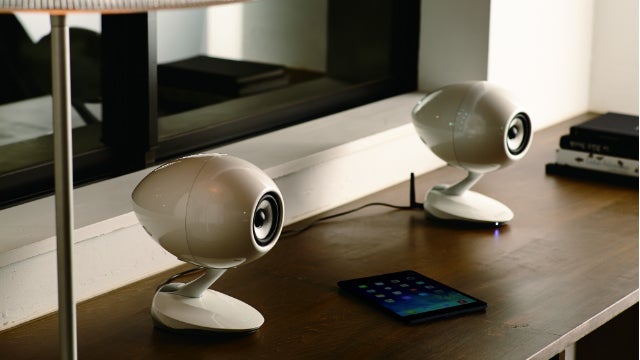
Verdict
Pros
- Robust high-end build quality
- Striking egg-shaped design
- Outstanding detail reproduction and imaging
Cons
- Browser-based setup
- Limited bass output
- Basic phone app
Key Specifications
- Review Price: £799.00
- AirPlay and DLNA playback
- High-resolution audio support (up to 192kHz/24-bit)
- 8cm full-range driver and Class D digital amp
- iOS/Android remote app
- 2 x USB ports
What is the Eclipse TD-M1?
The TD-M1 from Japanese brand Eclipse is a wireless desktop audio system that brings a bit of audiophile sparkle to your workspace. It’s been around since 2014 but thanks to some ‘favourable currency conditions’ in Japan, Eclipse has recently dropped the price of this hi-res capable system from £999 to £799, a great reason to find out what all the fuss is about.
Related: Best portable speakers 2016
Eclipse TD-M1 – Design and Connections
The TD-M1’s egg-shaped enclosures not only look stunning but have acoustic benefits too, suppressing the internal standing waves that can harm performance. It takes its design cue from models further up Eclipse’s range, such as the £6,500 TD-712.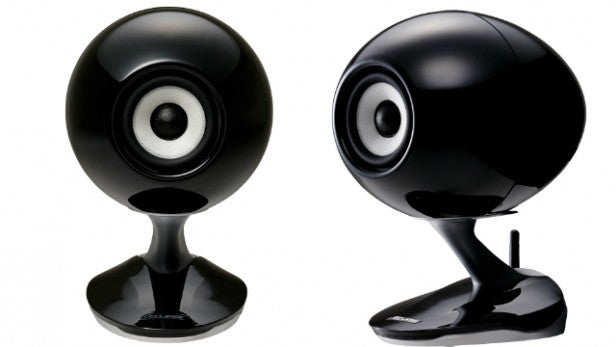
The system is available in a white or black lacquer finish and both versions are equally alluring. Their striking, distinctive design will make your desk look like something out of a sci-fi movie, with an angled silver stem connecting the main body to its sturdy base.
Built into said base is a panel of touch-sensitive controls, including volume up/down keys and a standby button that also lets you toggle through the various inputs. You can turn the volume up and down by running your finger over a row of dots. The volume level is displayed by a row of LEDs along the front edge, which glows different colours to indicate the current status or selected input.
Build quality is outstanding. The speakers are remarkably heavy and robust, but then I’d expect nothing less at this price. You can adjust the angle of the speaker up to 20º by opening a lever underneath, moving it into place and snapping it shut. The mechanism is clumsy but at least the speakers lock tightly into position.
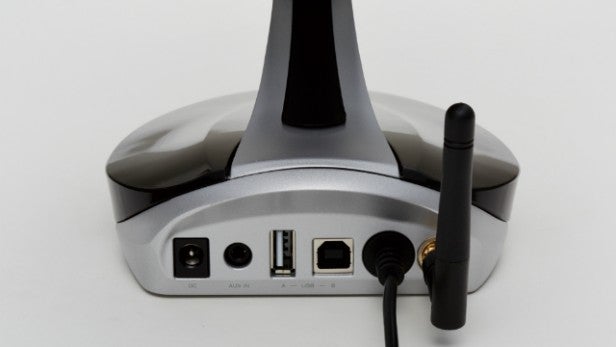
On the back of the right speaker are two USB ports – one Type A for Apple devices and one Type B to connect PCs and Macs. For the latter, you’ll need to install the Eclipse USB driver on your computer (available from the Eclipse website).
They’re joined by a 3.5mm minijack input for portable devices and a port for the supplied Wi-Fi antenna. A cable attached to the back connects to the left speaker.
Eclipse TD-M1 – Features
The TD-M1 supports AirPlay, allowing you to stream CD quality tracks (44.1kHz/16-bit) directly from iOS devices without going through a router. It also plays high-resolution audio files from other sources thanks to a 192kHz/24-bit DAC. You can play music via DLNA but you’ll need to use third-party software as Eclipse’s smartphone app only offers remote control functionality.
The speaker’s single 8cm full-range driver handles bass, midrange and treble and is fixed to a ground anchor that stabilises the unit as it moves. This, combines with a high-efficiency Class D digital amp, crossover-free drivers and an egg-shaped enclosure, results in what Eclipse descries as ‘class-leading sound accuracy’.
Eclipse TD-M1 – Setup and Operation
With no fancy app-based setup to fall back on, you have to connect the TD-M1 to your router using a PC or Mac browser. Connect to the Eclipse’s Wi-Fi network, type an IP address into the web browser and enter your Wi-Fi password into the relevant box.
Usually this PC-based process makes my heart sink but thankfully it didn’t pose any problems on my Windows 10 laptop. It was up and running in minutes. Tracks streamed via AirPlay with no annoying drop-outs and I was able to play music from my NAS drive through the Eclipse using the BubbleUPnP app.
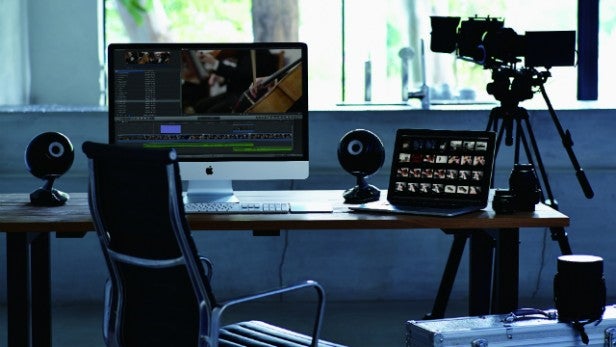
Similarly the TD-M1 worked flawlessly when I connected a laptop to the USB port – after downloading the necessary drivers, of course.
The touch controls on the base are nice and responsive but they’re no good if you want to tweak it from the sofa. With no physical remote in the box your best bet is to download Eclipse’s free TD remote app for iOS and Android smartphones.
It’s not the most sophisticated software in the world, using some rather dull backgrounds and graphics, but does a good job. On the Remote screen, you can change inputs by pressing the relevant icon or adjust the volume with the slider.
Meanwhile the Music Select menu displays any music stored on your phone (but not on DLNA devices) while Player offers a few transport controls, cover art and another volume slider. In the setup menu you can adjust the brightness of the LEDs and enable the DAC digital filter.
Eclipse TD-M1 – Performance
Listening to music through the TD-M1 is a revelation, provided you spend a little time getting them in the right position. Ideally, you want to toe them inwards with the drivers pointing directly at your ears. Once in place, the results are astonishing.
Firstly there’s loads of detail on offer. The TD-M1 teases out the finest textures and nuances, making for an utterly absorbing listen.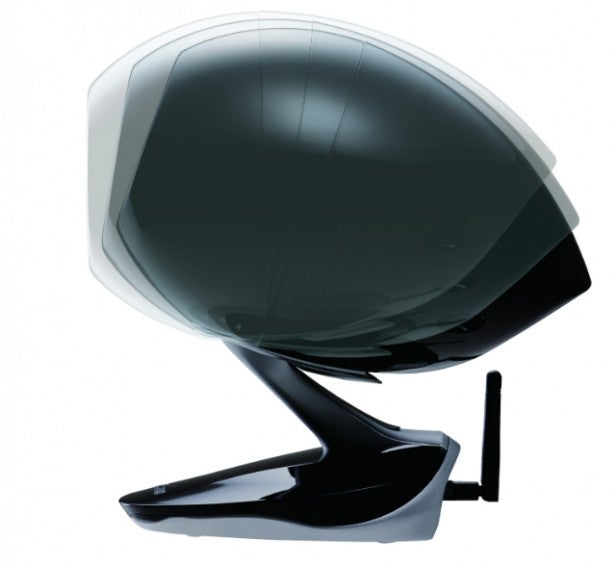
Its insightful presentation ensures that nothing gets lost in the mix. While playing Fool Me Once by Lindsey Webster, it revealed a male backing singer on parts of the chorus and a subtle ride cymbal that had previously escaped my attention. Every hi-hat, cymbal and rimshot sounds lucid and expressive, plus it lends Webster’s voice an intimate wisp that not every speaker can communicate.
Even more impressive is the TD-M1’s imaging. Instruments are precisely placed within its spacious soundstage, with Webster’s voice sitting in the space between the speakers. Warm keyboard chords pan smoothly between channels and reverb on snare drums is given room to breathe. Few speaker systems immerse you in the music quite like this one.
In terms of bass the TD-M1 isn’t the most muscular or powerful I’ve heard, but there’s just enough depth and punch to balance out the crisp treble and robust midrange. Playing an uptempo track like Gettin’ Up by Q-Tip, the drums hit hard, there’s grit in the bassline and you can hear the leading edge on the live bass guitar.
But more demanding dance tracks with lots of sub-bass and fatter kick drums reveal limitations in the TD-M1’s low-frequency performance. It won’t fill the room or make the floorboards shake, but in terms of poise, finesse and articulacy the Eclipse is a top performer.
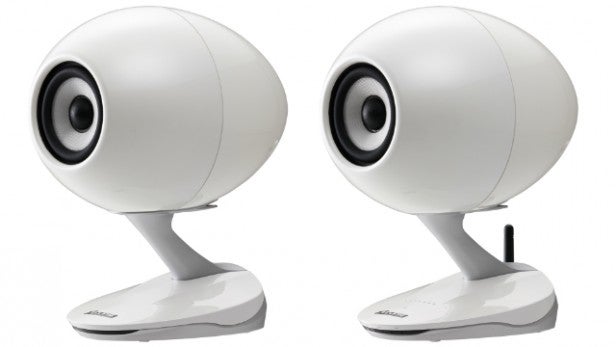
Should I buy the Eclipse TD-M1?
The TD-M1 was a must-buy even before the price drop, but now you’d be crazy not to give it an audition. It’s a fantastic desktop speaker system, offering the sort of expressive detail and immersive imaging that makes audiophiles go weak at the knees.
Its alluring egg-shaped design and luxurious build quality easily justify the price, while AirPlay, USB and DLNA support puts a decent range of music sources at your disposal. Setup could be slightly easier but poses few problems, while the simple smartphone app allows for easy operation from the sofa.
The only negative is the limited bass output and fussy positioning, but these are minor quibbles over an otherwise outstanding speaker system.
Verdict
Sublime build quality, striking design and spine-tingling sound converge in Eclipse’s stunning desktop system, which is now available at a more tempting price.
Trusted Score
Score in detail
-
Performance 8
-
Features 8
-
Value 8
-
Sound Quality 9
-
Design 9
Features
| Number of Speakers | 2 |
| Supported Channels | 2 |
Connectors
| Stereo Line In | 1 |
| Power (Watt) | 25W |
Physical Specifications
| Height (Millimeter) | 242mm |
| Width (Millimeter) | 155mm |
| Depth (Millimeter) | 219mm |
| Weight (Gram) | 5.3kg |

